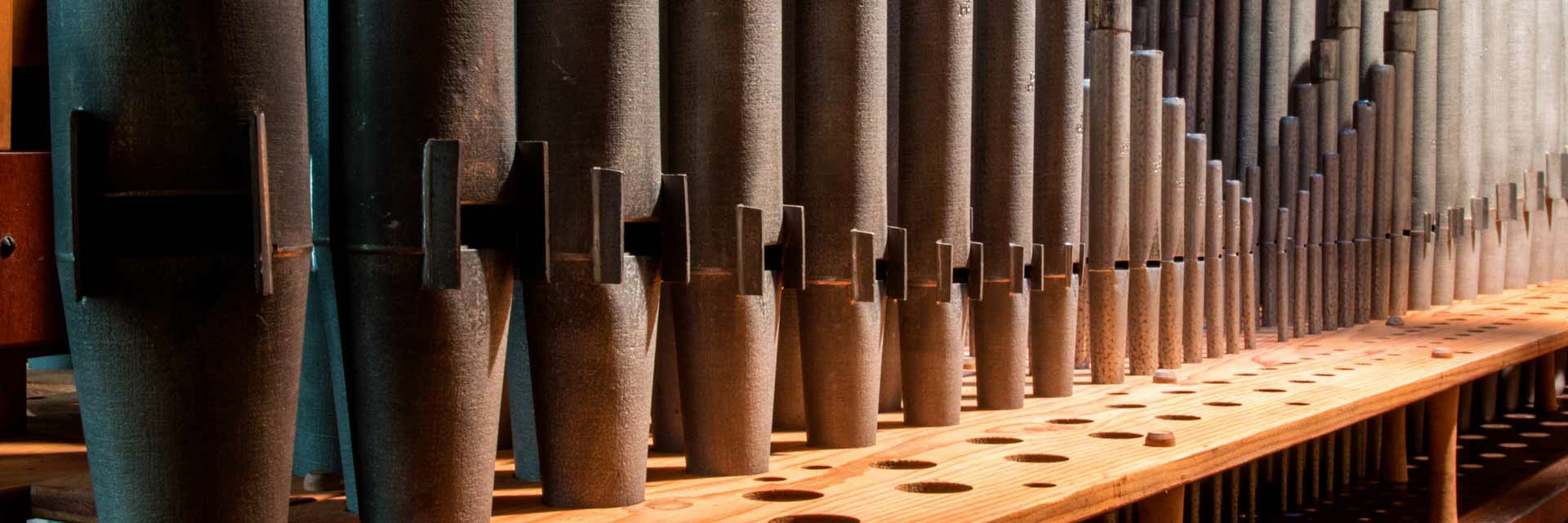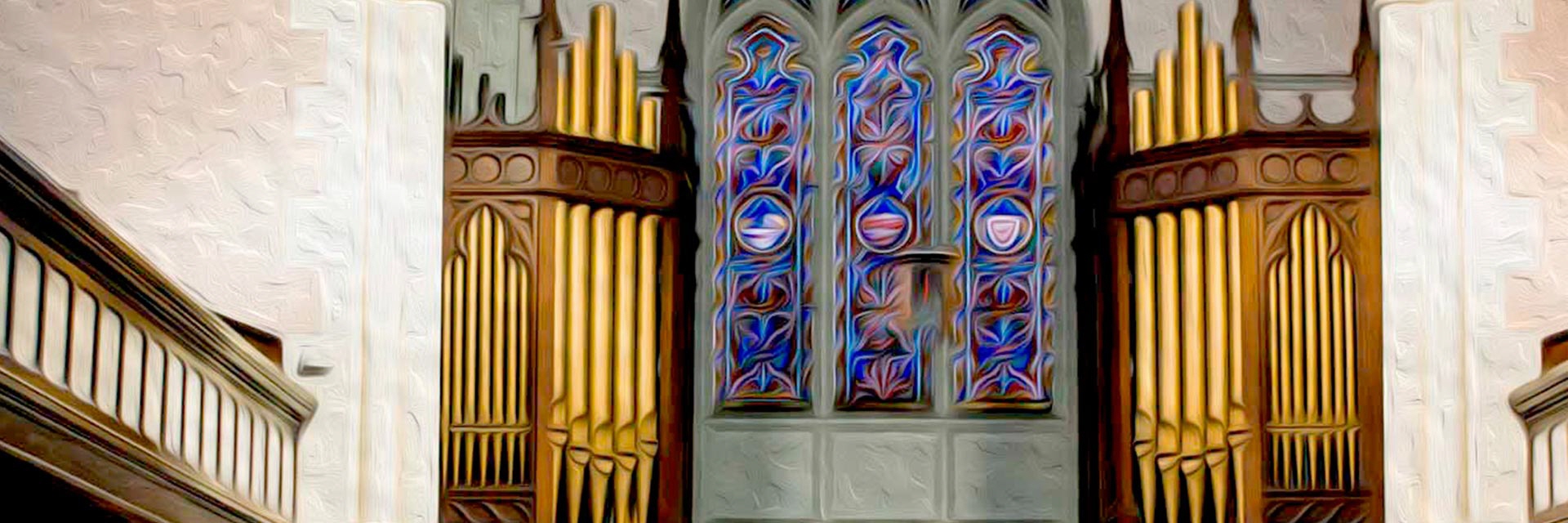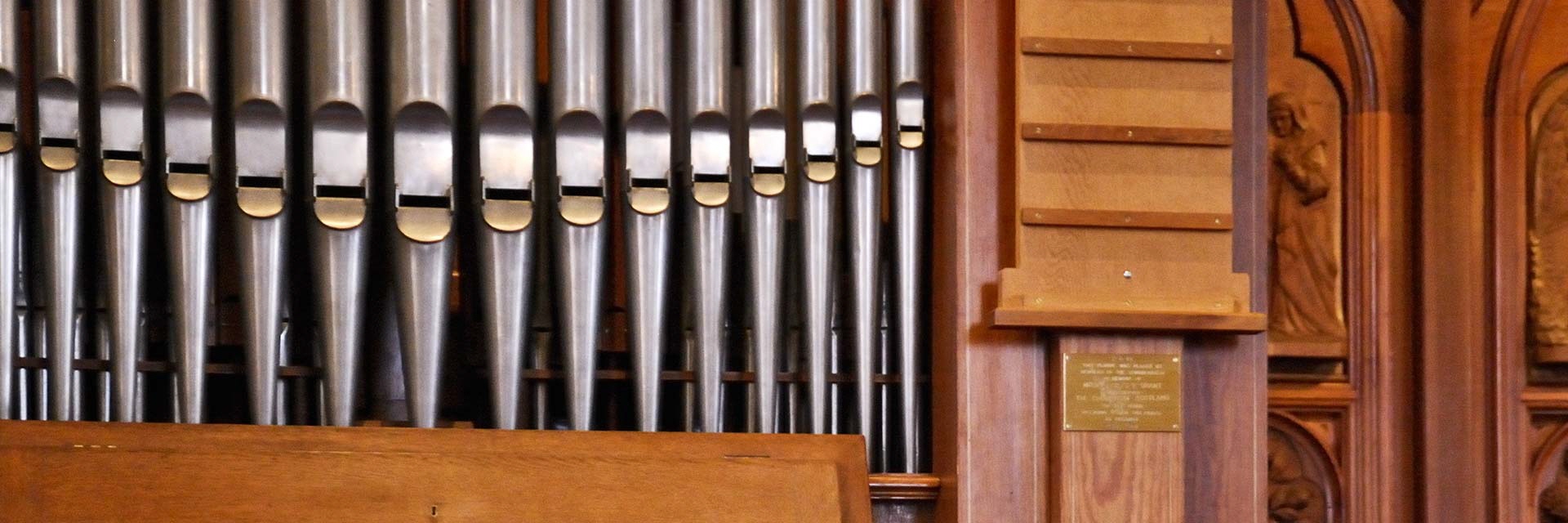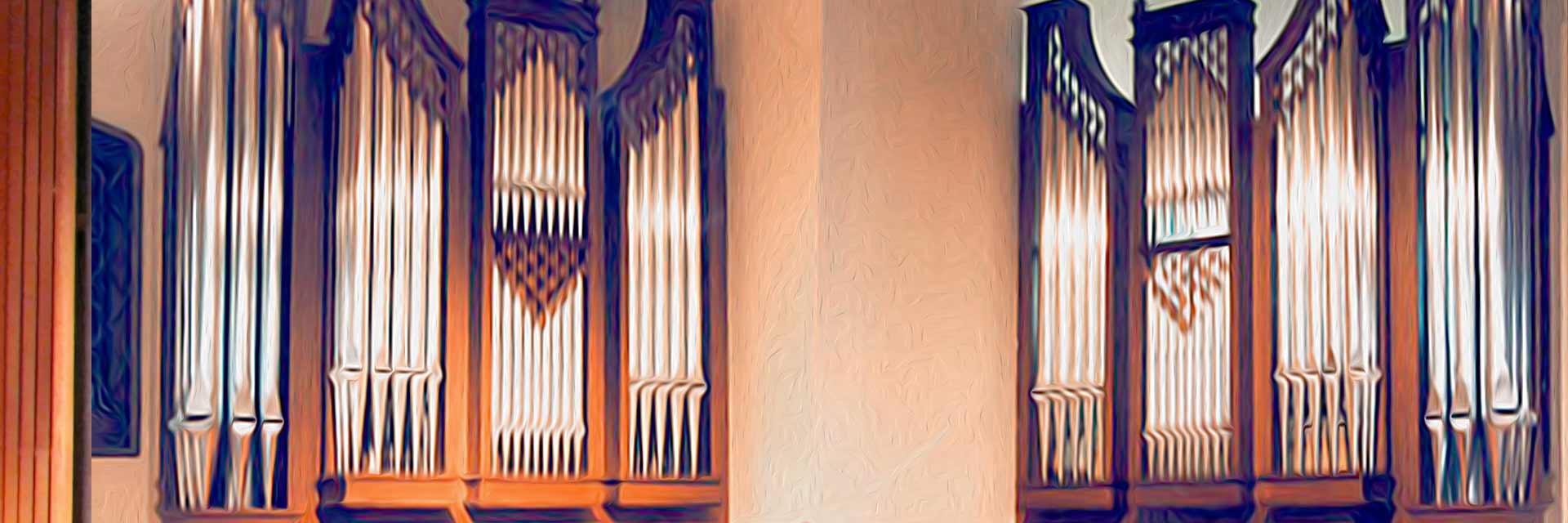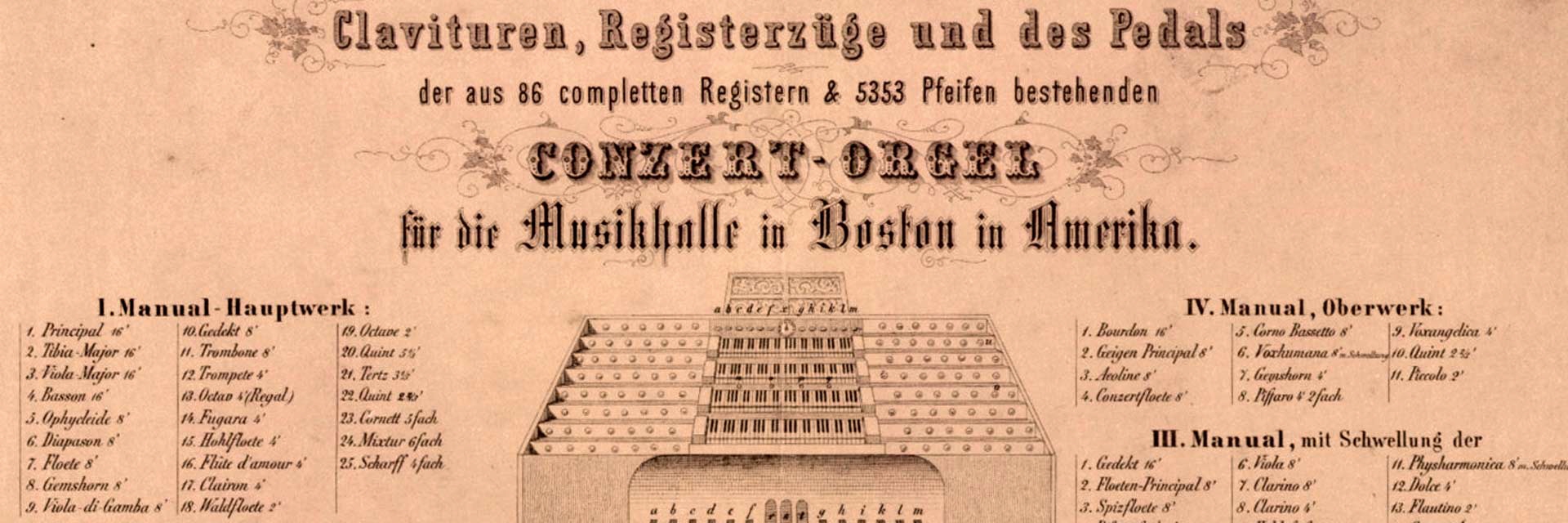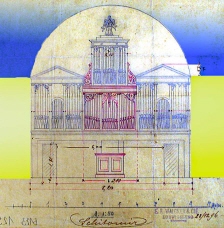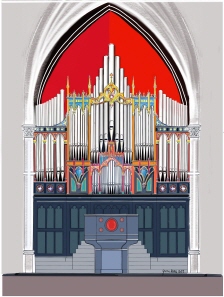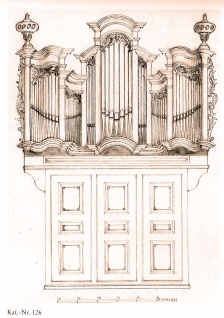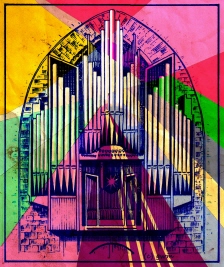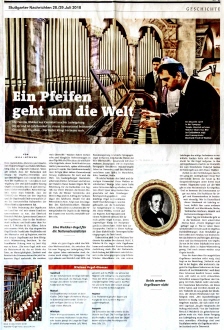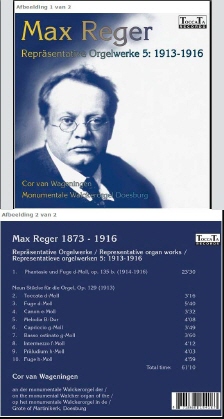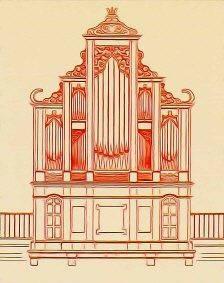The Organ in Riga Cathedral as viewed by the Walcker firm
Gerhard Walcker-Mayer March 2003
By the time when Eberhard Friedrich Walcker, the doyen of the Ludwigsburg organ building firm, passed away in 1872, three of his sons had already become firmly integrated into company activities for quite some time: organ builder Fritz (Johann Friedrich), organ builder Heinrich (Eberhard Heinrich) and qualified merchant Karl (Carl). The two younger sons Eberhard and Paul, also organ builders, were already in the midst of obtaining their own final qualifications. Thus, the Swabian firm, which had become a world-renowned enterprise ever since it had erected the Boston Music Hall Organ in 1862 (68 stops, IV manuals), continued to employ five highly qualified sons of Eberhard Friedrich Walcker from his death in 1872 until the year 1893.
This team of brothers, the third Walcker generation of organ builders, landed their first success at Vienna World's Fair in 1873, where four Walcker organs were put on display with the distinction of an honorary diploma. This resulted in the commissioning of a new organ for St. Stephen's Cathedral in Vienna (HI/90 stops, built in 1876) and of an organ for the Votive Church in Vienna III/61 stops, built in 1878).
Subsequently, the project emerged of building an organ for Riga Dom Cathedral Church. Commissioned in 1881, it was first completely installed for a trial run in the Ludwigsburg assembly hall. Mr. Bergner, the Riga Cathedral organist, traveled to Germany in order to play the instrument there. He was so happily impressed that he donated a commemorative plaque in expression of his gratitude and appreciation for the efforts of the father, Eberhard Friedrich Walcker. The plaque can still be seen on the outside of Walcker's birthplace home in Bad Cannstatt (now part of Stuttgart).
The organ was finally installed in Riga in 1883. It had 124 stops on four manuals; thus, at that time, it held the rank of largest organ in the world. It continued to be the largest in all of Europe until Paul Walcker built an even larger one in Breslau (Wroclaw).
In the Walcker firm's first promotional brochure published in 1902, the Riga instrument is the first one mentioned under the heading "New Organs" (as opposed to renewals). It had thus come to hold first place as the Walcker firm's most representative organ. This position had been formerly held by the organ in Ulm Cathedral, where, by the way, Eberhard Friedrich's sons had made manifest for the first time that they held views quite different from those of their father, since the organ which he had originally built there in 1856 (VI/100 ranks) was subsequently subjected to a number of changes in terms of outer form, re-disposition of the windchests, removal of double pedal, removal of Manual VI (for playing the reeds) and alterations in specification.
Eberhard Friedrich Walcker had at least designed the specification for the Boston Music Hall Organ himself, and we know for certain that the Boston organ featured Barker levers (the Walcker term was "pneumatic levers"). Furthermore, we know that the Walcker firm carried out a number of experiments in the area of pneumatic tracker action on that organ; the results, however, were unsatisfactory and not applied in the end.
The Boston organ was installed and voiced by Fritz Walcker, and his brother Paul was also temporarily involved in that project. This same team also worked on the Riga organ together: Paul Walcker installed it when he was 37 years old, and Fritz Walcker was 54 when he did the voicing. Both brothers had received a technical education at the Polytechnikum institute in Stuttgart. Oscar Walcker once described his father as having possessed the following traits: Fritz was a Swabian through and through, a staunch believer, simple and sincere, more natural than artificial, quite strict towards himself as well as towards others. The first thing he expected from employees was precise, punctual work. He was a specialist in the voicing of reeds.
The Walcker firm finally started experimenting with electro-pneumatic tracker action and with different types of windchests at a relatively late date: the ties to the father's former directives were still too strong. Not until 1890 did the workers become convinced that a certain technique which they had developed for a pneumatic cone-valve chest was good enough to qualify for a patent application-which the patent office then rejected, nonetheless. Subsequently, pneumatic tracker action was installed in the organ in Ulm Cathedral in 1899. Many attempts at such innovations were made, particularly by Paul Walcker. This, along with other circumstances, caused a violent quarrel with his brothers which finally led to a rupture between Paul and the others in 1892. Paul Walcker started working for the Sauer firm, where he was offered the job of "managing director", and of which he finally became the owner in 1910. All of these circumstances entailed, however, that the organ in Riga Dom Cathedral was still built in the traditional manner of Eberhard Friedrich Walcker and of its predecessor in Boston. Both organs were equipped with a mechanical cone-valve chest and with Barker levers; both organs feature the typical Walcker register crescendo with its round numerical watchface display, and the consoles have a straight horizontal stop jamb (as opposed to the semicircular one which was used for the first time by Walcker in the St. Petersburg organ in 1838, long before Aristide Cavaille-Coll). The keydesks on both organs have only one pedal keyboard (normally, two pedal keyboards on large organs had been a typical Walcker specialty, enabling the player to make rapid changes in dynamics with the feet alone).
Organ building in Germany was about to undergo some radical changes which had still not had their effect on the Walcker firm: when this finally happened, the firm's reaction to these upheavals turned out to be much more restrained than that of its competitors. Yet, apart from the Boston Music Hall Organ, another further predecessor of the Riga organ must be mentioned here: the organ built for Mulhouse in Alsace in 1866 (III manuals, 61 ranks), which was also voiced by Fritz Walcker. This is the instrument which led Albert Schweitzer to his lifelong interest for and mastery of the organ, and "it was magnificently voiced", as he wrote in a letter to my father in 1961. In other texts, Schweitzer indicated that the Walcker organ in Mulhouse and the organs of Andreas Silbermann were those instruments which most perfectly fulfilled his own ideal of what an organ should be. He particularly pointed out the Walcker organs mellow reed timbre, which he found was lacking in Cavaille-Coll organs.
The great Walcker organs from this period were built according to the timbre ideal of Eberhard Friedrich Walcker: the first manual always corresponds to the Hauptwerk, based on 16' or on 32' lower case, with full-compass principal chorus all the way to the 1' pitch and featuring 8' Cornet, 4' Mixture and 1 I/ 3' Scharff as uppermost crowning timbres; diverse tone color registers lie in between. Manual III is conceived as a kind of Echo or complementary tone color division with principal chorus capability (the swell-capable Vox Humana reed stop or, as here in Riga, the corresponding 4' Oboe is found on Manual II). In view of its function as Echo division, Manual III is only equipped with a Mixture and with the Cornet. Riga's Manual II is a Choir Organ with principal chorus reaching up to the 1 3/5' third-sound rank, whereas Manual IV, a division created for tone color purpose only, is enclosed in the swell box. The free reeds (here: Physharmonica) had always been equipped with their own wind scoops. The two pedal divisions reflect the makers' original intention of creating two pedal keyboards. Here, in Riga, the final result was a 32'-based main pedal and a Piano Pedal in the swell box, which can nevertheless only be played by one pedal keyboard. In this case, Walcker did not make the Baroque distinction between wide and narrow stops, but he replaced that historical trait with a wide array of tone color registers. This was the manner of specification as used by the Walcker firm until the end of the Late Romantic period, besides the use of further, finer Late Romantic nuances and degrees as applied here in the organ of Riga Cathedral. The basis for all of those specifications could be found in the Walcker organ built for the Paulskirche in Frankfurt between 1827 and 1833 (III manuals, 74 stops), which, however, had still been made with slider chests. The cone-valve chest or Kegellade was used for the first time by Walcker in the town of Kegel in 1842 (this unusual coincidence between the town's name and the new device surely had a certain influence on that innovation; Walcker, nevertheless, originally referred to this new type of windchest with the archaic term Springlade-spring chest-and not Kegellade, as it would be called in the future).
The manner of specification as applied by Eberhard Friedrich Walcker and, later on, by his sons, originated in the thought of the Abbe Vogler, the first musician ever to have distinguished organ registers in terms of quality and quantity and who specifically demanded that the harmonic rows be extended all the way up to 1' pitch. Eberhard Friedrich met Vogler in Bad Cannstatt. He studied the master's theories thoroughly and applied Vogler's principles in re-voicing the organ in that town's municipal church.
The aforementioned Frankfurt Paulskirche organ was the instrument which made Walcker's name world-famous. One person who heard it, however, found that it was not loud enough-that person was Aristide Cavaille-Coll himself. What would that master have said if he had been able to hear the organ in Riga Dom Cathedral, based on the same principles yet reflecting 50 further years of technical innovation?
The organs in Riga Dom Cathedral and in the Votive Church in Vienna are the only instruments stemming from the great age of the Walcker firm in the 1800's which are still preserved in their original state. Both organs have undergone restoration of outstanding quality and they represent the culmination of the art of Eberhard Friedrich Walcker's sons. Just as the Frankfurt Paulskirche organ inspired composers of the likes of Felix Mendelssohn Bartholdy, the Riga organ also served as inspiration for the musical creativity of Franz Liszt and of Max Reger. The latter composer played on many Walcker organs, among which particular mention can be made of the Gewandhaus organ in Leipzig, built in 1884 (III manuals, 54 ranks), where the voicing was also carried out by Fritz Walcker.
Fritz Walcker died on 6 December 1895; with his parting, the world lost a man who possessed a unique culture of timbre which is still kept alive in Riga. Let us hear Albert Schweitzer in his own words once more: "When I was a child, I played on Walcker organs which were built during the halcyon days of that great house: the 1860's and 1870's." In this text, pertaining to his short book "A 1927 afterword to the art of German and French organ building", Schweitzer goes on to regret the fact that the same house, the Walcker firm, rebuilt the Mulhouse organ in 1899 in such a way that its original, beautiful sound was lost. This should serve to us all as a reminder that a certain timbre is associated, in the end, not with a firm or with its name, but with a vision as carried out by one unique human being.
Gerhard Walcker-Mayer
